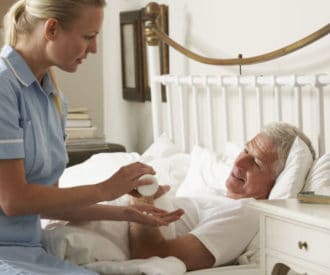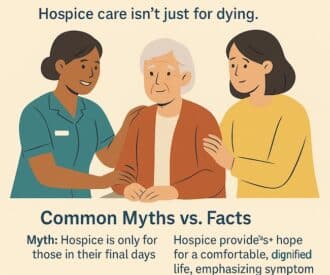
Understanding the facts about dying reduces guilt and fear
Death is a mysterious and scary concept. Because there’s so much we don’t know about the dying process and what happens after death, dozens of myths and misconceptions have developed over the ages.
Many of these incorrect beliefs can add unnecessary guilt, fear, or stress. Understanding the truth about what to expect and what's a normal part of the process can help make this transition more peaceful for everyone involved. Here, we explain the truth behind 5 common myths about dying.
Myth #1 If I'm not there when my loved ones die, I’ve failed them.
Popular Belief: If I’m not there when they pass, they won’t know that I love them. They’ll feel so alone.
Truth: The timing of death itself is a complete mystery. Some people seem to wait for someone to arrive or for everyone to leave the room before they die. Don’t judge yourself for being there at the final moment or not. That may have been how your older adult wanted it to happen.
Myth #2 I have to do everything I can to prevent death
Popular Belief: If I don’t use every possible technology and treatment available or if I stop using machines to keep someone alive, then I’m basically killing them.
Truth: Advanced age or disease is what kills your older adult, not you. Even though advanced treatments and technology are available, it doesn’t mean those options are always right for your older adult. Sometimes, aggressive treatments only prolong the dying process rather than give life.
Myth #3 I have to make sure they keep eating and drinking
Popular Belief: I have to do everything possible to make sure they don’t starve to death or die of dehydration.
Truth: Don’t be alarmed if your older adult refuses food or water. The body’s ability to process food and water changes in the final months of life. People don’t die because they aren’t eating; they don’t eat because they’re dying. Also, natural dehydration causes less chances of nausea and vomiting, swelling, and lung congestion.
Myth #4 Dying only happens in hospitals
Popular Belief: Almost everyone dies in a hospital.
Truth: People die at home every day. They’re usually kept comfortable and pain-free by home care or hospice care. Home might be a private home, a nursing home, an assisted living facility, or a hospice residence. No matter where, a home setting is usually more peaceful for both the older adult and their family.
Myth #5 People should be conscious until the moment of death.
Popular Belief: Toward the end of life, something is wrong if people are sleeping a lot, extra tired, or confused.
Truth: The dying process almost always causes someone to sleep more and more, until they drift into a coma. Sleepiness and confusion are usually caused by natural changes in the body as it begins to shut down.
Recommended for you:
— 5 Myths About Hospice Care
— How to Talk About End-of-Life with Seniors
— POLST: Why Your Older Adult May Need One
By DailyCaring Editorial Team
Image: The Guardian
[optin-monster slug=”yxbytm35zhsdfopnw7qk”][optin-monster slug=”jvhyplxmb4umsjazxecn”]
About the Author

Connie Chow
Connie was a hands-on caregiver for her grandmother for 20 years. (Grandma made it to 101 years old!) She knows how challenging, overwhelming, and all-consuming caring for an older adult can be. She also knows how important support is — especially in the form of practical solutions, valuable resources, and self-care tips.





Some people who are in a hospice beleive there is a chance to suvive, why take away there beleif,its what keeps them going in a posative way….talking polite about dying can create real hurt and suffering….every one is an individual,and there needs are differant….there is NO straightforward answer…people,s feelings vary,and its so important to have an understanding of the individual.
Yes, each person and situation is different, so families must make their own decision on whether or not to talk with the person about their dying.